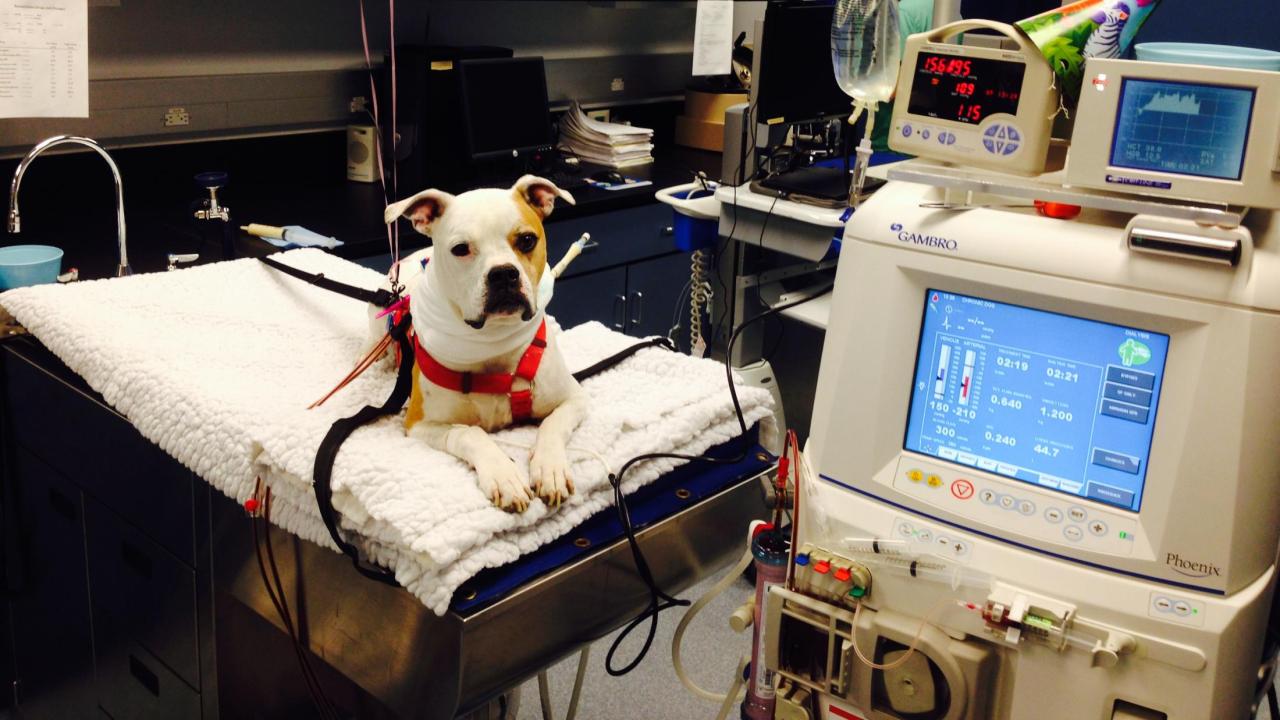
Dog Forges on After Year on Dialysis
If you let her off her leash at the front door of the UC Davis veterinary hospital, Bebe, an 8-year-old American bulldog, could probably find her own way to the Hemodialysis Suite. That’s because for the last year, Bebe has been coming to UC Davis twice a week for dialysis treatments. Bebe is so well known that she can’t walk the halls of the hospital without a dozen people stopping her to say hello.
It’s a special day for Bebe, and she is drawing even more attention than usual, as she traverses the halls with balloons attached to her. Today marks her one-year anniversary of hemodialysis treatments, and her care team—comprised of veterinarians, technicians, and students—have brought a cake for the team, and a bowl of treats for Bebe. Her success with treatments is certainly worth celebrating.
Five years ago, Bebe suffered an acute kidney injury of unknown origin that damaged her kidneys to the point where dialysis was the only way to keep her feeling well. At that time, she was treated with hemodialysis at UC Davis for just over a month. The hemodialysis treatments helped to remove toxins from her body until her kidneys healed enough to allow her to be managed with a special diet. A few years later, however, her kidney disease had worsened, and soon she would need routine dialysis to keep her feeling well. By the spring of 2014, Bebe had become a regular visitor to UC Davis.
Twice a week now, Bebe’s dedicated owners drive the nearly 200-mile round trip from their home in the south Bay Area. As UC Davis is one of only a handful of facilities in the country to offer hemodialysis for animals—and one of only two on the west coast (UC Davis’ satellite facility in San Diego being the other)—they have no other choice for Bebe. They wouldn’t have it any other way, as Bebe has thrived over the last year at home with her family.
“Bebe’s worth it,” they said. “She loves the attention and special treatment she gets from everyone at UC Davis.”
Each of Bebe’s treatments takes upwards of five hours. After so many visits, she’s used to the routine, and seems to enjoy the sessions. During the dialysis treatments, Bebe is content to relax for the day as she naps on the treatment table, readily eats snacks (that are doctor approved), and receives affectionate attention from her care team.
The first clinical program in the nation dedicated to providing hemodialysis services to client-owned dogs with naturally occurring renal failure was established in 1990 at UC Davis. The history of renal medicine at UC Davis, however, goes back to 1976 when Dr. Larry Cowgill arrived on campus following graduate training at the University of Pennsylvania, which at that time was one of the only veterinary schools experimenting with hemodialysis procedures. Dr. Cowgill brought that knowledge to UC Davis, and over the course of the next 40 years, helped UC Davis evolve into a world leader in renal medicine.
Dr. Cowgill, along with Dr. Carrie Palm, lead the Hemodialysis and Blood Purification Unit at UC Davis, helping dogs like Bebe continue to lead full lives.
It’s a special day for Bebe, and she is drawing even more attention than usual, as she traverses the halls with balloons attached to her. Today marks her one-year anniversary of hemodialysis treatments, and her care team—comprised of veterinarians, technicians, and students—have brought a cake for the team, and a bowl of treats for Bebe. Her success with treatments is certainly worth celebrating.
Five years ago, Bebe suffered an acute kidney injury of unknown origin that damaged her kidneys to the point where dialysis was the only way to keep her feeling well. At that time, she was treated with hemodialysis at UC Davis for just over a month. The hemodialysis treatments helped to remove toxins from her body until her kidneys healed enough to allow her to be managed with a special diet. A few years later, however, her kidney disease had worsened, and soon she would need routine dialysis to keep her feeling well. By the spring of 2014, Bebe had become a regular visitor to UC Davis.
Twice a week now, Bebe’s dedicated owners drive the nearly 200-mile round trip from their home in the south Bay Area. As UC Davis is one of only a handful of facilities in the country to offer hemodialysis for animals—and one of only two on the west coast (UC Davis’ satellite facility in San Diego being the other)—they have no other choice for Bebe. They wouldn’t have it any other way, as Bebe has thrived over the last year at home with her family.
“Bebe’s worth it,” they said. “She loves the attention and special treatment she gets from everyone at UC Davis.”
Each of Bebe’s treatments takes upwards of five hours. After so many visits, she’s used to the routine, and seems to enjoy the sessions. During the dialysis treatments, Bebe is content to relax for the day as she naps on the treatment table, readily eats snacks (that are doctor approved), and receives affectionate attention from her care team.
The first clinical program in the nation dedicated to providing hemodialysis services to client-owned dogs with naturally occurring renal failure was established in 1990 at UC Davis. The history of renal medicine at UC Davis, however, goes back to 1976 when Dr. Larry Cowgill arrived on campus following graduate training at the University of Pennsylvania, which at that time was one of the only veterinary schools experimenting with hemodialysis procedures. Dr. Cowgill brought that knowledge to UC Davis, and over the course of the next 40 years, helped UC Davis evolve into a world leader in renal medicine.
Dr. Cowgill, along with Dr. Carrie Palm, lead the Hemodialysis and Blood Purification Unit at UC Davis, helping dogs like Bebe continue to lead full lives.
# # #
